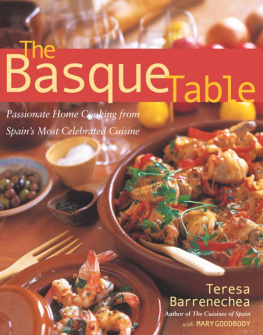LIEUTENANT NUN

M E M O I R O F
A B A S Q U E
T R A N S V E S T I T E
I N T H E N E W
W O R L D
C a t a l i n a d e E r a u s o
Translated from the Spanish by
Michele Stepto and Gabriel Stepto
F o r e w o r d b y M a r j o r i e G a r b e r
B e a c o n P r e s s B o s t o n
for Robert and Rafael
and for Carlos, in memoriam
FOREWORD
The Marvel of Peru
Another world was searched through oceans new
To find the Marvel of Peru ;
And yet these rarities might be allowed
To man, that sovereign thing and proud,
Had he not dealt between the bark and tree,
Forbidden mixtures there to see.
A NDREW M ARVELL,
The Mower Against Gardens (1681)
H ow can we assess the erotic, social, and political effects of cross-dressing at a remove of almost four centuries, in the context of a culture very different from our own, and as described in a Spanish-language text? The short answer, of course, is that we cant. In the fascinating and fantastic adventures of the Lieutenant Nun doa Catalina de Erauso, who cross-dressed her way out of a Spanish convent and into the New World, what we read, what we find, is a version of ourselves.
When Catalina de Erauso fights duels, steals money, leads soldiers into battle, rescues a woman in distress, evades the marriage plans of hopeful widows and their daughters, and marches across league upon league of uncharted Peruvian terrain, it is tempting to see in her tale an allegory of early modern womans emergent subjectivity. When, acting as a second for a friend whose honor has been insulted, she kills her brother unknowingly and inadvertently, it seems possible to see her as a version of Shakespeares Viola in Twelfth Night , stepping into the shoesand the clothingof the brother she believes is dead. (It is a happy coincidence that her hometown in Spain is San Sebastian, the name of Violas lost brother.) When Catalina flirts with two young women, frolicking and teasing, it might seem intriguing to read this as lesbianism avant la lettre , an instance of female homosexuality or, at the very least, love play between women. Yet all these readings are allegoricalthat is to say, they are readings of her story as a story about something else , readings that offer her lifeas indeed saints and others lives have been offered in the literary annals of her time and oursas exempla , as indications of deeper or higher truths.
Such modern readings are no more allegorical, it is perhaps needless to say, than the readings offered within the text itself: the search for the king on Holy Thursday that culminates in his discovery on Easter, the revelation that after all her adventuring (and horseback-riding) the Lieutenant Nun remains virgo intacta , the close-calls (or clothes-calls? or close-shaves?) in which she encounters first her father, then her mother, shortly after her cross-dressed flight from the confines of the convent, and neither parent recognizes her. She is already someone else. As a story about emergent subjectivity, male or female, early modern or postmodern, Catalina de Erausos narrative is a literal description of self-fashioning, in which, quite literally, clothes make the man.
We may ourselves mistake subject for object, or discourse for subjectivity, when we regard Catalinas self as stable, and her costumes and roles as shifting. One thing that is very striking about this memoir is the materiality of clothing, and its value. Recall that this is a time period far removed from the mass production of garments and the availability of ready-to-wear. Clothing was wealth, and even identity. Actors in the theater wore noblemens hand-me-downs, and were criticized for social-climbing, a transvestism of rank or status as well as of gender. Catalinas payment from benefactors and employers is frequently a suit of clothes, and she describes these gifts with distinct pleasure and gratitude. They help to transform her, again quite literally, into another person, with a new status as well as a new gender. Clothes offer sensuous pleasure, wealth, status, and social roles.
Leaving the convent Catalina says she shook off my veil and spent three days and nights (the Christological interval is perhaps not inadvertent) re-making herself anew, cutting a pair of breeches from her blue woollen bodice, a doublet and hose from her green petticoat. Not long after this transformation, she describes herself finding work as a page and resembling a well-dressed young bachelor.
Pages are often described in Renaissance literature as beautiful young boys who looked (almost) like girls, and could be regarded as sexual partners for men as well as women. Malvolio in Shakespeares Twelfth Night correctly reads Violas femininity when she is dressed as the boy Cesario, though he doesnt realize what he sees. A male page in The Taming of the Shrew is dressed in womens clothes and pretends to be the wife of the drunken tinker, Christopher Sly. The fantastical Spaniard Don Armado in Loves Labours Lost rehearses his love-discourse with a page in the court of Navarre. In the Forest of Arden Rosalind chooses as her alias no worse a name than Joves own page ( As You Like It 1.3.124), and the name she adopts is Ganymede, a slang term in the period for boy lover or male prostitute. Since on the English public stage during the Renaissance female parts were played by boy actors, a complex eroticism attends these impersonations. Rosalind as Ganymede at the height of the plots foolery is a boy (actor) playing a girl playing a boy playing a girl. Madam, undress you, and come now to bed, says Christopher Sly to the page he thinks is his wife, only reluctantly agreeing, at the last minute, to substitute a stage-play for immediate love play in despite of the flesh and the blood.
In the real life situations of Renaissance courtesans and prostitutes, whofor example, in Veniceoften dressed as boys, the frisson of gender undecidability might be reversed, with provocative results for the flesh and the blood. You talk like a fair lady and act like a pageboy, wrote the sixteenth-century author Pietro Aretino approvingly to a courtesan in the Italian town of Pistoia. Masculine clothing was stylish not only in Renaissance Italy but also in England and in France, where in the sixteenth century no less a personage than Marguerite de Navarre was described as both handsomely and bewilderingly attired: You cannot tell whether she is male or female. She could just as well be a charming boy as the beautiful lady that she is.
In a later time period equally titillated by gender crossover, Lady Caroline Lamb sat for her portrait in the costume of a page, and appeared in that guise at the door of her lover, the romantic poet Lord Byron. He was a fair-faced delicate boy of thirteen or fourteen years old, whom one might have taken for the lady herself, a visitor reported of the cheeky young page. In an instance of literature accompanying if not imitating life, Byrons poem Lara centers on a male page who is revealed to be a girl, with a hand So femininely white it might bespeak/Another sex.
The cultural and erotic fascination with pages, their borderline genders and sexualities (together with the literary and sexual fantasy of turning the page), continued on through the early twentieth century. In the 1920s lesbian poet Rene Vivien, dressed as a page, posed for a photograph with her lover Natalie Barney. Pageboy haircuts were the standard feminine style for conventional women in the 1950s (the same period that favored so-called little boy leg-styles on womens tailored bathing suits). Where the page was once a young man who could be taken for a young woman, he/she had become, by the early part of this century, a young woman who resembled an elegant if somewhat anachronistic young man.
Next page










